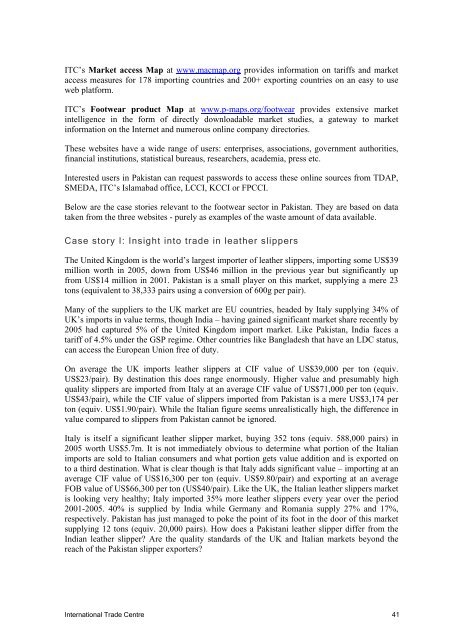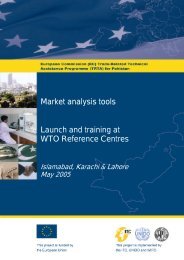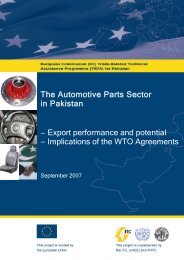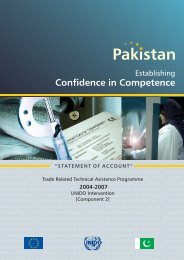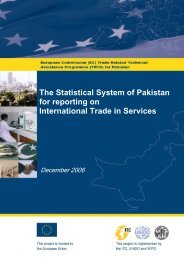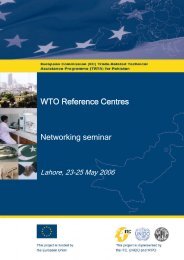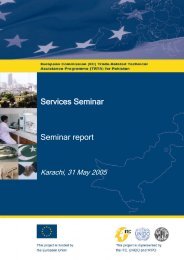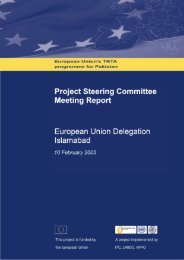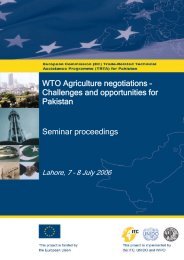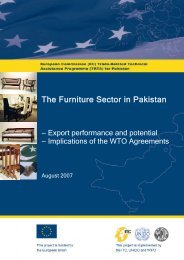The Sports Goods Sector in Pakistan - TRTA i
The Sports Goods Sector in Pakistan - TRTA i
The Sports Goods Sector in Pakistan - TRTA i
Create successful ePaper yourself
Turn your PDF publications into a flip-book with our unique Google optimized e-Paper software.
ITC’s Market access Map at www.macmap.org provides <strong>in</strong>formation on tariffs and marketaccess measures for 178 import<strong>in</strong>g countries and 200+ export<strong>in</strong>g countries on an easy to useweb platform.ITC’s Footwear product Map at www.p-maps.org/footwear provides extensive market<strong>in</strong>telligence <strong>in</strong> the form of directly downloadable market studies, a gateway to market<strong>in</strong>formation on the Internet and numerous onl<strong>in</strong>e company directories.<strong>The</strong>se websites have a wide range of users: enterprises, associations, government authorities,f<strong>in</strong>ancial <strong>in</strong>stitutions, statistical bureaus, researchers, academia, press etc.Interested users <strong>in</strong> <strong>Pakistan</strong> can request passwords to access these onl<strong>in</strong>e sources from TDAP,SMEDA, ITC’s Islamabad office, LCCI, KCCI or FPCCI.Below are the case stories relevant to the footwear sector <strong>in</strong> <strong>Pakistan</strong>. <strong>The</strong>y are based on datataken from the three websites - purely as examples of the waste amount of data available.Case story I: Insight <strong>in</strong>to trade <strong>in</strong> leather slippers<strong>The</strong> United K<strong>in</strong>gdom is the world’s largest importer of leather slippers, import<strong>in</strong>g some US$39million worth <strong>in</strong> 2005, down from US$46 million <strong>in</strong> the previous year but significantly upfrom US$14 million <strong>in</strong> 2001. <strong>Pakistan</strong> is a small player on this market, supply<strong>in</strong>g a mere 23tons (equivalent to 38,333 pairs us<strong>in</strong>g a conversion of 600g per pair).Many of the suppliers to the UK market are EU countries, headed by Italy supply<strong>in</strong>g 34% ofUK’s imports <strong>in</strong> value terms, though India – hav<strong>in</strong>g ga<strong>in</strong>ed significant market share recently by2005 had captured 5% of the United K<strong>in</strong>gdom import market. Like <strong>Pakistan</strong>, India faces atariff of 4.5% under the GSP regime. Other countries like Bangladesh that have an LDC status,can access the European Union free of duty.On average the UK imports leather slippers at CIF value of US$39,000 per ton (equiv.US$23/pair). By dest<strong>in</strong>ation this does range enormously. Higher value and presumably highquality slippers are imported from Italy at an average CIF value of US$71,000 per ton (equiv.US$43/pair), while the CIF value of slippers imported from <strong>Pakistan</strong> is a mere US$3,174 perton (equiv. US$1.90/pair). While the Italian figure seems unrealistically high, the difference <strong>in</strong>value compared to slippers from <strong>Pakistan</strong> cannot be ignored.Italy is itself a significant leather slipper market, buy<strong>in</strong>g 352 tons (equiv. 588,000 pairs) <strong>in</strong>2005 worth US$5.7m. It is not immediately obvious to determ<strong>in</strong>e what portion of the Italianimports are sold to Italian consumers and what portion gets value addition and is exported onto a third dest<strong>in</strong>ation. What is clear though is that Italy adds significant value – import<strong>in</strong>g at anaverage CIF value of US$16,300 per ton (equiv. US$9.80/pair) and export<strong>in</strong>g at an averageFOB value of US$66,300 per ton (US$40/pair). Like the UK, the Italian leather slippers marketis look<strong>in</strong>g very healthy; Italy imported 35% more leather slippers every year over the period2001-2005. 40% is supplied by India while Germany and Romania supply 27% and 17%,respectively. <strong>Pakistan</strong> has just managed to poke the po<strong>in</strong>t of its foot <strong>in</strong> the door of this marketsupply<strong>in</strong>g 12 tons (equiv. 20,000 pairs). How does a <strong>Pakistan</strong>i leather slipper differ from theIndian leather slipper? Are the quality standards of the UK and Italian markets beyond thereach of the <strong>Pakistan</strong> slipper exporters?International Trade Centre 41


